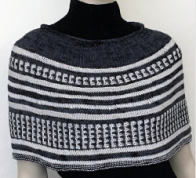It is my absolute pleasure to introduce Cecelia Campochiaro to you all, my readers. My sequence of how I got to know Cecelia: First, I learned from Lisa Souza that she had written a beautifully done book on knitting. Second, I went to our trade show TNNA and actually met Cecelia while she was signing books there. Third, I made sure that I will meet with her over coffee to get to know her and what she is doing better. In conclusion of my sequence I was so thrilled to learn that she looked at knitting stitch patterns from the mathematical point of view and came up with the simple solution that anyone can use to create different fabrics. What she is done is artistic, creative, inspiring, and plain beautiful. Now we can learn together more about Cecelia and her creative work.
1. When did you start knitting and who taught you?
When I was 12 a friend’s mother taught me how to knit. I spent a lot of time planning knitting, but when it actually came to doing the knitting I was never happy with my work. The interaction of fiber, gauge, tension were fuzzy in my mind until I took up knitting again later in life. My thoughts on these subjects continues to evolve, but suffice it to say that I am now happy with most things I make, because if I start something and it is not going well I know enough to stop and rethink it before investing all that effort.
